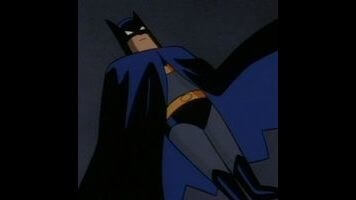Rehabilitation stories are a great way of delving into a villain’s psyche, and “Double Talk” reveals how crippling a mental disorder can be for a bad guy who is trying to make good. Arnold “The Ventriloquist” Wesker has been able to keep his Scarface personality at bay for six months, but when he’s released from Arkham, he begins to hear and see his dummy self everywhere. Luckily, he has a guardian angel on his side, and Batman is able to figure out who is manipulating Wesker before he gets into too much trouble.
The episode begins with an eerie dream sequence, using the color yellow to great effect as Wesker tries to find paradise but is attacked by a trunk holding his evil alternate personality. Bright yellow isn’t a color we see very often on this show (with the exception of the Bat-Signal), and as a color associated with insanity, it works especially well for Wesker’s dream. This scene is when we get our first listen of Shirley Walker’s flute flourish that will reappear throughout the episode when Scarface begins to rear his head, a cheerful sound that is hiding something malevolent underneath.
In Wesker’s dream we see Scarface, a demonic Batman, and Wesker’s old henchmen Mugsy and Rhino, the two men who will try to revive Scarface and the Ventriloquist when their old boss gets out of prison. Wesker has become even more of a schlub with his revamped character design, losing almost all of his remaining hair and now wearing see-through glasses to spotlight his beady eyes. His body language makes him look like he’s constantly in fear, especially when he’s put side-by-side with a broad, perfect-postured man like Bruce Wayne.
Not only does Bruce Wayne offer Wesker a place to live and a new job as a mail runner at his company, but he also goes out of his way as Batman to make sure that Wesker won’t slip into bad habits. It’s nice to see this side of Batman, the one who takes a proactive stance in helping cured villains reintegrate in society—and part of that job is beating up whatever random henchmen appear to pressure their old bosses into getting back in the game. Pressure in this case means rigging Wesker’s house with a speaker so that he randomly hears Scarface’s voice, and hiring a little-person actor to impersonate Scarface on the street and make Wesker believe that his other half has truly gained sentience.
This is the first episode of The New Batman Adventures that is able to capture the emotional punch of the strongest stories in Batman: The Animated Series, a Hitchcockian suspense thriller where it’s unclear if the threat is inside Wesker or not. The direction in this episode also seems to be more cinematic than the past few episodes, especially during the fight sequences. There’s a particularly striking fight sequence in a statue studio, pitting Batman against a miniature gangster and a whole lot of sculpting stone.
While working at Wayne Enterprises, Wesker overhears Bruce and Lucius Fox talking about $2 million worth of bearer bonds they’re storing in the vault, which is probably when Scarface begins to creep his way out of whatever mental prison Wesker was able to set up at Arkham. Mugsy and Rhino think they were pulling Wesker’s strings, but Scarface was always in control, and when he finally does rise back to the surface of Wesker’s consciousness, he makes sure to take care of his henchmen who have overstepped their bounds. (This past October, John Layman wrote a short story about henchmen who think too big for their own good for a fantastic issue of Detective Comics, a series that has quickly become one of DC’s best books.) Scarface has always been the brains of the operation, and when he finally confronts Mugsy and Rhino, he tells them that he was just biding his time until the heat was off, just waiting for the right moment. It’s unacceptable when the muscle starts growing a brain and threatens the boss, so Scarface tosses a bomb at them and lets them fall to their deaths—that is if Batman and Batgirl didn’t show up to save them.
The power play going inside Arnold Wesker’s head is one of the most fascinating internal conflicts in Batman’s rogues gallery, and this week’s episode ends on a chilling but positive note as Wesker chooses to shoot-up Scarface rather than his old henchmen. We’ve seen the emotional impact that losing Scarface has had to Wesker in the past, but when he riddles the dummy with bullets and then watches it get turned to sawdust by spinning turbines, he’s unfazed by the destruction. It can be an incredible challenge, but sometimes a villain really can be rehabilitated, and judging by the lack of Scarface appearances after “Double Talk,” it looks like Arnold Wesker is one of the rare success cases. Part of that is due to his own work, but he couldn’t have done it without Batman watching over his shoulder.
Stray observations:
- Batman Beat-down: It’s a simple but brutal beat-down this week, as Batman goes to preventative measures to keep Wesker’s old thugs away from him by kicking their asses all over the street. My favorite moment: the classic backhand over the shoulder to knock out the guy that’s attacking from behind.
- I’m assuming Hips McManus got his name because he only comes up to people’s hips when standing next to them.
- Batman using his grappling gun to send a bomb through an air vent is a genius move—it’s always nice to see gadgets used in different ways.
- “Guess I’m just no good at playing the tough guy.”


 Keep scrolling for more great stories from A.V. Club.
Keep scrolling for more great stories from A.V. Club.